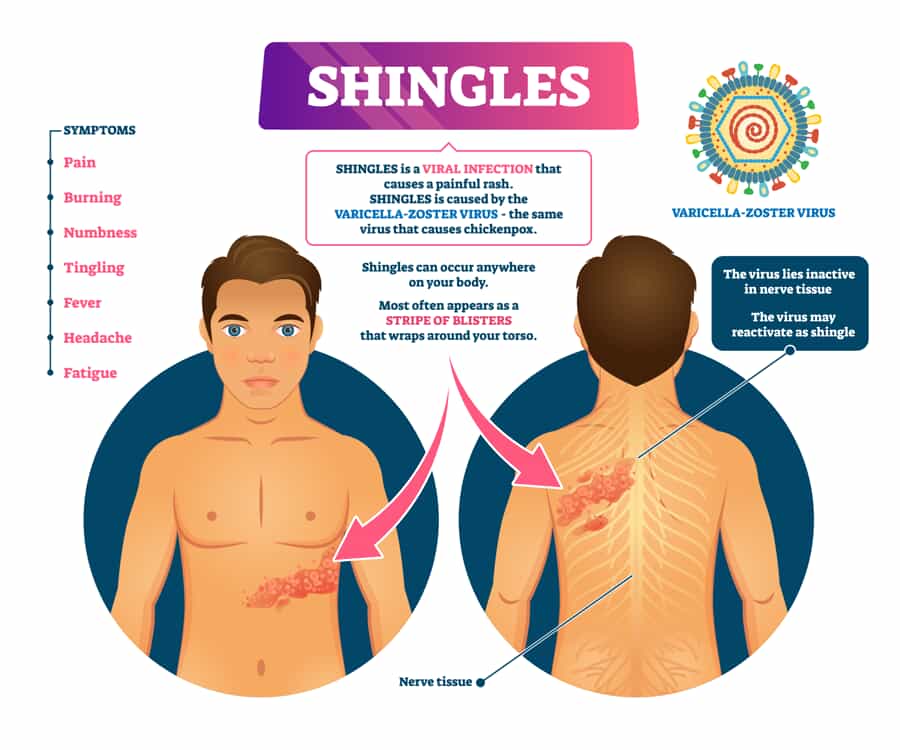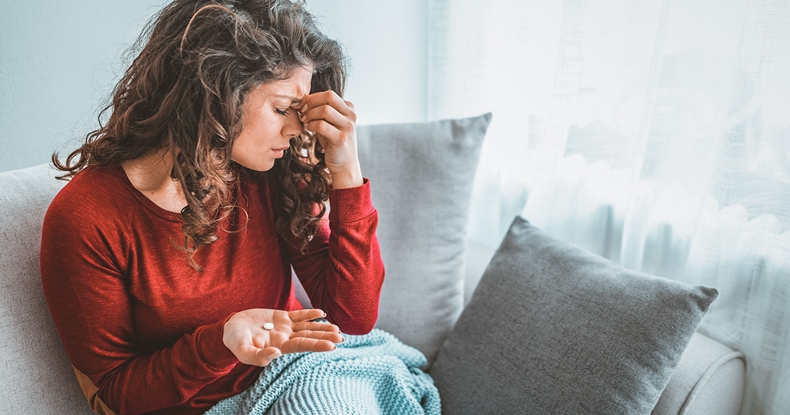Shingles and Shingrix, Everything People Need to Know
- Category: Health & Wellness, Infection Prevention
- Posted On:
- Written By: LVMC

Nearly 1 million people get shingles each year in the United States, and almost 1 out of 3 people will develop shingles in their lifetime. You can get it at almost any age, but it is more common in older adults. In most cases, shingles last anywhere from 3 to 5 weeks. Symptoms can range from mild to severe. Want to know more about shingles and how you can prevent it? Read on to learn more about this common health condition and how to protect yourself.
What is Shingles?
Remember getting chickenpox as a child? Shingles is a painful skin rash caused by the same virus that causes chickenpox — varicella-zoster (sometimes referred to as herpes zoster). Shingles typically show up on one side of the body, often in a strip, and looks like a skin rash with blisters. Until these blisters dry up and scab over, you are contagious and can infect someone with chickenpox (not shingles!) if they haven’t had it yet or have not been vaccinated.
Most people who get shingles experience it only one time, though it is possible to get shingles more than once.

How Do People Get Shingles?
Once you’ve had chickenpox, the varicella virus lays dormant in your body. In some people, it stays dormant forever. In others, the virus “wakes up” when stress, aging, illness, and/or certain medications weaken the immune system, making you more susceptible to the virus being reactivated in the body.
Shingles aren’t contagious — you can’t catch it from someone who has it. But there is a chance that the shingles rash can spread to another person who hasn’t had chickenpox or been vaccinated for it.
You are at a higher risk for developing shingles if:
- You have had the chickenpox.
- You are 50 and older.
- You have a weakened immune system due to another health condition.
- You are under a lot of stress or experienced recent trauma.
- You have cancer or are receiving treatment for cancer.
- You take medicines that suppress your immune system (i.e., steroids).
If you have an outbreak of shingles, you can help prevent the virus from spreading to other people. Cover any of your fluid-filled blisters with clothing. Keep your blisters clean, and avoid itching and scratching. Wash your hands frequently and do not spend time with immuno-compromised individuals until you are well.
What are the Symptoms of Shingles?
Shingles symptoms appear in predictable stages. The severity of symptoms varies from person to person, but most cases follow a similar pattern.
Prodromal stage (pre-rash)
- Burning, tickling, itching sensations around the affected area several days or a week before a rash appears. Discomfort is most common on the chest or back but can occur anywhere on the body, most typically only on one side.
- Flu-like symptoms (no fever) such as achy joints, chills, stomach ache, and diarrhea
- Swelling and tenderness in lymph nodes around the affected area
Active stage
- Rash and blisters appear — typically in a band or strip on one side of the body
- Blisters form and fill with a clear fluid
- Pain described as “piercing needles” and “stabbing” may occur on and near the rash
- Blisters break open, ooze, and crust over in 5-10 days
- The rash takes approximately 2-4 weeks to clear up, some scars may remain
Postherpetic neuralgia (PHN) (in some cases)
- Aching, burning and stabbing sensations where shingles rash occurred
- Persistent pain that does not relent over weeks, months, and even up to years
- Extremely sensitive to touch
- The pain with PHN occurs most often on the chest and forehead. This can interfere with daily activities
The intensity of the shingles rash varies from person to person. Some people don’t get a rash at all, while others may experience more severe blistering.
If you think you have shingles, call your healthcare provider right away. Getting early treatment can help you feel better sooner. If you have shingles near your eyes and nose, it is important to get checked right away, as shingles in the eye may cause permanent damage.
Some people who had shingles experience postherpetic neuralgia, the most common side effect of shingles.
What Is Postherpetic Neuralgia?
Approximately 10-18 percent of people who get shingles will experience a common complication called postherpetic neuralgia (PHN). This shows up in the areas where your shingles rash was on the body after the rash clears up. This nerve pain can last for months and even years after the rash disappears. Sometimes, the pain can be debilitating and affect your day-to-day life.
Older adults are most vulnerable to PHN and tend to have longer-lasting symptoms than a younger person with shingles.
Who is at Risk of Getting Shingles?
Anyone who had the chickenpox can get shingles. People ages 50 and older and those with a vulnerable immune system or underlying health conditions are more susceptible, even if they are younger than 50.
Older adults and those who are immuno-compromised (e.g., HIV+, autoimmune disorders) get shingles most often. The severity of shingles and its complications increase with age.
How Do I Get Diagnosed with Shingles?
Healthcare providers can typically identify shingles when they see a rash around the left or right side of your body. If a diagnosis is not clear, your doctor may order lab tests (such as the herpes test), or take a sample of the fluid from one of the blisters.
If you have any reason to believe you may have shingles, see your doctor immediately. Early treatment with antiviral medicines is key to help shorten the length of the illness and prevent complications like postherpetic neuralgia.
Are There Home Remedies for Shingles?
If you have shingles or suspect you may, it is important to see your healthcare provider right away so they can prescribe you antiviral medication as well as any pain medications if your pain is severe. There are things you can do to help ease your discomfort and expedite your healing at home, including:
- Keep your skin sores clean: do not scratch or pick at the blisters. Let them crust over and fall off naturally.
- Use cool, moist compresses if the itching becomes intense.
- Apply baking soda or cornstarch to help the sores dry out quickly.
- Ask your doctor about topical pain creams to relieve inflammation and swelling.
- Use non-prescription pain medications such as ibuprofen and acetaminophen to help reduce pain and swelling.
- Take your prescribed medications as instructed to treat and clear up shingles as quickly as possible.
How Do I Protect Myself from Shingles?
Getting shingles is no picnic. Fortunately, there is a vaccine available to help protect against an outbreak and prevent postherpetic neuralgia — a painful and common complication from shingles.
The CDC recommends that adults ages 50 years and older get two doses of the shingles vaccine — Shingrix — to prevent shingles and associated complications from the disease. Research shows that the Shingrix vaccine is more than 90 percent effective at preventing shingles, and protection stays at 85% for at least 4 years after getting the vaccine.
Healthy adults 50 years and older should get two doses of Shingrix, separated by 2 to 6 months.
If you’ve already had shingles, you can still get the Shingrix vaccine to prevent further outbreaks.
Who Should Get the Shingrix Vaccine?
If you are 50 and older, you should get the Shingrix vaccine, even if you’ve had shingles in the past, or are not sure if you’ve had chickenpox. Shingrix is available in doctor’s offices and pharmacies and is available to anyone ages 50 and older. If you are younger, you will need to speak with your healthcare provider about getting the vaccine.
How Well Does Shingrix Work?
The Shingrix vaccine requires two shots spaced approximately 2 to 6 months apart. It protects against shingles and postherpetic neuralgia. According to the CDC, Shingrix is 97 percent effective in preventing shingles in those aged 50-69 years old, and 91 percent effective in those aged 70 and older.
Are There Side Effects to Shingrix?
Research shows that Shingrix is safe. The vaccine helps your body build a defense against the varicella zoster virus that causes shingles. You may experience some mild side effects from getting the shots, such as a sore arm with mild pain after getting Shingrix. Some people experience redness and swelling around the area where they got the shot. You may experience a headache, fatigue, stomach pain, or nausea, but these typically pass after 2-3 days and are not experienced by everyone who gets the vaccine.
What is the Treatment for Shingles?
Once you are diagnosed with shingles, your doctor will start antiviral medications such as acyclovir, famciclovir, or valacyclovir, to reduce the pain and the duration of a shingles outbreak.
Your doctor may suggest over-the-counter pain medications such as acetaminophen or ibuprofen to help reduce swelling and pain. If your pain is severe, your doctor may prescribe pain medications to help alleviate some of your discomfort.
You may be given topical antibiotics to apply to the skin to prevent your blisters from becoming infected.
Starting an antiviral medication as soon as you notice your first symptoms is the best way to shorten the duration of the virus and the severity of the rash. The antiviral medication typically works best when taken in the first three days of experiencing symptoms.
Conclusion
Shingles is a painful rash caused by the varicella-zoster virus that is most common in adults over the age of 50. The Shingrix vaccine is the best way to protect yourself against the virus. Speak to your healthcare provider today to get the vaccine and protect your health.




